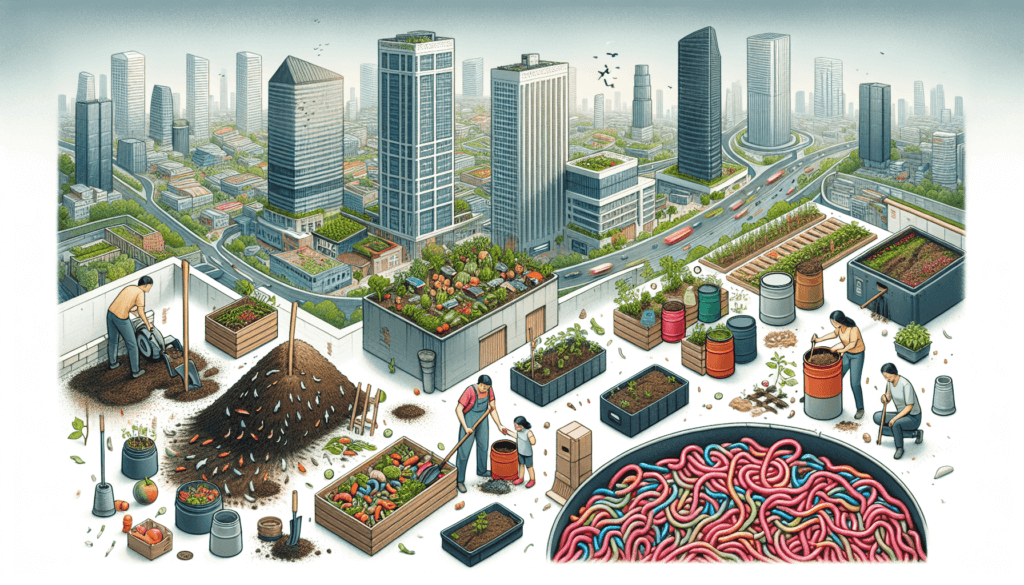If you’re an urban gardener looking for ways to maximize the health and productivity of your plants, composting is the answer you’ve been searching for. In this article, we will explore the top methods for making compost in your urban garden so that you can transform kitchen scraps and yard waste into nutrient-rich soil. With these tried and tested techniques, you’ll be able to reduce your carbon footprint, minimize waste, and create a sustainable garden that flourishes with every season. Say goodbye to the limitations of urban gardening and hello to a thriving oasis right in the heart of the city.

Choose the Right Compost Bin
Consider the Size of Your Urban Garden
When choosing a compost bin for your urban garden, it’s important to consider the size of your garden space. If you have limited space available, there are compact compost bins that can fit in small corners or even on your balcony. On the other hand, if you have a larger garden area, you may have more options for larger compost bins. It’s important to choose a bin that fits well within your urban garden to optimize space efficiency.
Determine Your Preferred Compost System
There are several different composting systems to choose from, depending on your preferences and needs. Some popular options include traditional compost bins, which can be open or closed, as well as tumblers and worm bins. Each system has its own benefits and considerations, so it’s important to research and determine which system aligns best with your goals and gardening practices.
Select a Bin that Fits Your Space
Once you have determined the size of your urban garden and chosen your preferred composting system, it’s time to select a bin that fits your space. Consider the dimensions of the bin and ensure that it can fit comfortably in the designated area. It’s also important to think about accessibility for turning or harvesting the compost. Choose a bin that is easy to work with and suits your space constraints while still providing enough capacity for your composting needs.
Gather Compostable Materials
Collect Kitchen Scraps
Kitchen scraps are a valuable source of compostable materials. Collect fruit and vegetable peels, coffee grounds, eggshells, and other organic waste generated in your kitchen. Avoid including meat, dairy, or oily foods, as they can attract pests and produce unpleasant odors in the compost. By collecting and recycling kitchen scraps, you can contribute to the nutrient-rich compost that will nourish your urban garden.
Save Yard Waste
Yard waste, such as leaves, grass clippings, and small twigs, can also be added to your compost pile. By saving and recycling these materials, you not only reduce waste in your garden but also provide a diverse mix of organic matter for your compost. Keep in mind that larger branches or woody materials may take longer to decompose, so consider chopping or shredding them before adding them to the compost.
Include Paper Products
Paper products, such as shredded newspaper, cardboard, and paper towel rolls, can be excellent sources of “brown” materials for your compost. These materials provide carbon-rich content that helps balance the nitrogen-rich “green” materials in your compost pile. Remember to avoid using glossy or colored paper, as these may contain harmful chemicals that can contaminate the compost.
Avoid Certain Materials
While there are many organic materials that are suitable for composting, it’s important to avoid certain materials that can disrupt the composting process or introduce harmful elements into your garden. Avoid including meat, dairy, and oily foods, as mentioned earlier. Additionally, steer clear of weeds that have gone to seed, as the seeds may survive the composting process and spread in your garden. Lastly, avoid composting diseased plants or plants treated with herbicides or pesticides, as their remnants may linger in the compost and negatively affect your garden.
Maintain the Balance of Green and Brown Materials
Understanding Green and Brown Materials
To maintain a healthy compost pile, it’s crucial to understand the concept of green and brown materials. Green materials, such as fresh grass clippings and kitchen scraps, are rich in nitrogen and provide the necessary nutrients for microorganisms to break down organic matter. On the other hand, brown materials, like dried leaves and shredded paper, are carbon-rich and help maintain a balanced carbon-to-nitrogen ratio in the compost.
Achieving the Right Ratio
To achieve a compost pile with ideal conditions for decomposition, it’s important to maintain the right ratio of green to brown materials. Aim for a roughly equal amount of green and brown materials in volume or weight. This balance ensures that there is enough nitrogen to allow microorganisms to thrive, while also preventing the compost from becoming too dry or too compact. Adjust the ratio if necessary by adding more green or brown materials accordingly.
Chop or Shred Larger Materials
Breaking Down Organic Waste
Larger organic waste, such as branches, stalks, or larger vegetable scraps, may take longer to decompose in your compost pile. To speed up the decomposition process, consider chopping or shredding these larger materials into smaller pieces. By breaking them down into smaller sizes, you create more surface area, allowing the microorganisms in the compost to break them down more efficiently.
Using a Mulcher or Hand Tools
There are several methods you can use to chop or shred larger materials. One option is to use a mulcher or chipper, which is a machine specifically designed for breaking down yard waste. Another option is to use hand tools like pruners or shears to manually cut or shred materials into smaller pieces. Choose the method that suits your needs and equipment availability to effectively break down larger materials for your compost.

Layer Your Compost Pile
Creating a Balanced Stack
Layering your compost pile is an effective way to encourage decomposition and create a well-balanced mixture. Start by laying down a layer of twigs or straw at the bottom of your compost bin to allow for proper airflow. Then, alternate between layers of green and brown materials, ensuring a roughly equal volume or weight of each. This layering technique helps create a balance between carbon and nitrogen, promoting healthy decomposition.
Alternating Green and Brown Layers
As you layer your compost pile, alternate between green and brown materials to achieve the correct balance. Each layer should be roughly 2-3 inches thick. The green layers provide the necessary nitrogen for decomposition, while the brown layers help maintain the correct moisture levels and prevent the compost from becoming too wet.
Incorporating Amendments
During the layering process, you may also choose to incorporate amendments to enhance the quality of your compost. This could include items such as garden soil, finished compost, or organic fertilizers. These additions can introduce beneficial microorganisms or provide essential nutrients that may be lacking in your compost pile. However, be cautious not to add too many amendments, as it may disrupt the natural decomposition process.
Keep Your Compost Moist
Understanding Moisture Levels
Moisture is an essential component of a healthy compost pile. It creates the right environment for microorganisms to thrive and break down the organic matter. The moisture level in your compost should be similar to that of a damp sponge – not too soggy or too dry. Too much moisture can lead to a lack of oxygen and unpleasant odors, while too little moisture can slow down the decomposition process.
Providing Sufficient Water
To maintain the correct moisture level in your compost pile, it’s important to provide sufficient water. If your compost becomes too dry, sprinkle it with water using a watering can or a hose with a gentle spray attachment. Aim to keep the compost consistently moist, but not soaked. If rain is not providing enough water, remember to regularly check the moisture level and adjust accordingly.

Turn and Mix the Compost Regularly
Importance of Turning and Mixing
Regularly turning and mixing your compost pile is important to ensure proper aeration and even decomposition. Turning the pile helps to introduce oxygen, which is crucial for the breakdown of organic matter by microorganisms. Mixing the materials helps distribute moisture and encourages the blending of different components, resulting in a more consistent and well-composted mixture.
Frequency and Techniques
The frequency of turning and mixing your compost pile depends on various factors, including the size of your pile and the composting system used. As a general guideline, aim to turn or mix your compost at least once a week. Use a garden fork or a compost turning tool to gently lift and mix the materials. Avoid over-mixing, as it may disrupt the balance of microorganisms and slow down the decomposition process.
Monitor and Adjust Compost Conditions
Monitoring Temperature
Monitoring the temperature of your compost pile is a valuable way to ensure that microbial activity is taking place. A healthy compost pile will go through temperature fluctuations, starting with higher temperatures as the materials decompose, and then gradually cooling down as the process nears completion. Regularly check the internal temperature of the pile using a compost thermometer to ensure that it remains within the optimal range for decomposition, between 90°F and 140°F.
Addressing Potential Issues
While composting, certain issues may arise that require your attention. For example, if your compost pile is not decomposing properly and the temperature remains consistently low, it may indicate a lack of nitrogen or insufficient moisture. In this case, consider adding more green materials or water to the pile. Conversely, if your compost pile becomes too wet and starts to emit a foul odor, it may be a sign of excessive moisture. In this situation, turn the pile more frequently and consider adding dry brown materials to absorb excess moisture.
Troubleshooting Odor Problems
Unpleasant odors in your compost can be a sign that something is amiss. Usually, these odors are caused by anaerobic conditions, indicating a lack of oxygen or excessive moisture. To address the issue, turn the pile more frequently to introduce oxygen and improve airflow. Consider adding additional dry brown materials to absorb excess moisture. If strong odors persist, it may be necessary to adjust the composting process or seek expert advice to correct any imbalances.

Harvest and Use Your Compost
Signs of Finished Compost
Determining when your compost is ready for use in your urban garden is an exciting moment. Finished compost typically has a dark, crumbly texture and an earthy smell. The original materials should be unrecognizable, indicating that they have broken down completely. The compost should also be cool to the touch and have a uniform consistency. Once these signs are visible, your compost is ready to be harvested and incorporated into your garden.
Harvesting Methods
There are different methods for harvesting compost, depending on the type of composting system you use. With traditional compost bins, you can harvest by removing the finished compost from the bottom of the bin, while leaving the unfinished material in place to continue decomposing. Tumblers can be rotated to separate the finished compost from the unfinished material. For worm bins, you can separate the worms from the compost by creating a simple separation system. Whichever method you choose, be careful not to remove all the compost, as leaving some behind ensures a continuous source of beneficial microorganisms.
Applying Compost in Your Urban Garden
Once you have harvested your compost, it’s time to put it to use in your urban garden. Compost can be used as a soil amendment by incorporating it into existing soil, either by tilling or gently mixing it in. It can also be used as a top dressing around plants or as a component in potting mixes. The rich nutrients and organic matter in compost improve soil structure, moisture retention, and nutrient availability, resulting in healthier plants and increased productivity in your urban garden.
Consider Vermicomposting in Small Spaces
Introduction to Vermicomposting
Vermicomposting, also known as worm composting, is an excellent option for those with limited space in their urban gardens. This method utilizes special composting worms, such as red wigglers, to efficiently break down organic waste into nutrient-rich castings. Worms consume the organic matter and excrete nutrient-rich castings, which make an excellent natural fertilizer for plants. Vermicomposting can be done indoors or in small outdoor bins, making it a practical solution for urban gardeners with limited space.
Setting Up a Worm Bin
To set up a worm bin for vermicomposting, you will need a container with drainage holes for excess moisture to escape. Line the bottom with a layer of bedding material, such as shredded newspaper or coconut coir, to create a comfortable environment for the worms. Add your compostable kitchen scraps and cover them with a layer of bedding material. Finally, introduce the red wiggler worms to the bin and cover it with a breathable lid. Place the worm bin in a suitable location, away from direct sunlight and extreme temperatures.
Managing Your Worm Composting System
Maintaining a successful worm composting system involves providing the right conditions for the worms and managing their food supply. Keep the bedding material moist but not soggy to ensure the worms can move easily and maintain their moisture balance. Feed the worms regularly with kitchen scraps, avoiding citrus fruits, onions, garlic, oily foods, and meat. Monitor the moisture level and adjust as needed. As the worms populate and produce castings, harvest the finished compost periodically, ensuring to leave enough bedding and worms to sustain the system. The harvested worm castings can be directly used as a nutrient-rich fertilizer for your urban garden.
In conclusion, making compost in your urban garden is a rewarding and environmentally-friendly practice. By choosing the right compost bin, gathering compostable materials, maintaining the balance of green and brown materials, chopping or shredding larger materials, layering your compost pile, keeping it moist, regularly turning and mixing it, monitoring and adjusting compost conditions, harvesting and using your compost, and considering vermicomposting in small spaces, you can successfully create nutrient-rich compost to enhance the health and productivity of your urban garden. Happy composting!



